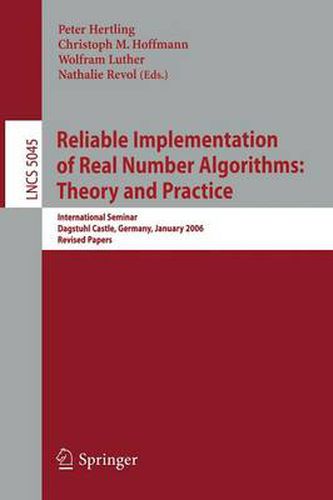Readings Newsletter
Become a Readings Member to make your shopping experience even easier.
Sign in or sign up for free!
You’re not far away from qualifying for FREE standard shipping within Australia
You’ve qualified for FREE standard shipping within Australia
The cart is loading…






This title is printed to order. This book may have been self-published. If so, we cannot guarantee the quality of the content. In the main most books will have gone through the editing process however some may not. We therefore suggest that you be aware of this before ordering this book. If in doubt check either the author or publisher’s details as we are unable to accept any returns unless they are faulty. Please contact us if you have any questions.
A large amount of the capacity of today’s computers is used for computations that can be described as computations involving real numbers. In this book, the focus is on a problem arising particularly in real number computations: the problem of veri?edor reliablecomputations. Since real numbersare objects c- taining an in?nite amount of information, they cannot be represented precisely on a computer. This leads to the well-known problems caused by unveri?ed - plementations of real number algorithms using ?nite precision. While this is t- ditionally seen to be a problem in numerical mathematics, there are also several scienti?c communities in computer science that are dealing with this problem. This book is a follow-up of the Dagstuhl Seminar 06021 on Reliable Imp- mentation of Real Number Algorithms: Theory and Practice, which took place January 8-13, 2006. It was intended to stimulate an exchange of ideas between the di?erent communities that deal with the problem of reliable implementation of real number algorithms either from a theoretical or from a practical point of view. Forty-eight researchers from many di?erent countries and many di?erent disciplines gathered in the castle of Dagstuhl to exchange views and ideas, in a relaxed atmosphere. The program consisted of 35 talks of 30 minutes each, and of three evening sessions with additional presentations and discussions. There were also lively discussions about di?erent theoretical models and practical - proaches for reliable real number computations.
$9.00 standard shipping within Australia
FREE standard shipping within Australia for orders over $100.00
Express & International shipping calculated at checkout
This title is printed to order. This book may have been self-published. If so, we cannot guarantee the quality of the content. In the main most books will have gone through the editing process however some may not. We therefore suggest that you be aware of this before ordering this book. If in doubt check either the author or publisher’s details as we are unable to accept any returns unless they are faulty. Please contact us if you have any questions.
A large amount of the capacity of today’s computers is used for computations that can be described as computations involving real numbers. In this book, the focus is on a problem arising particularly in real number computations: the problem of veri?edor reliablecomputations. Since real numbersare objects c- taining an in?nite amount of information, they cannot be represented precisely on a computer. This leads to the well-known problems caused by unveri?ed - plementations of real number algorithms using ?nite precision. While this is t- ditionally seen to be a problem in numerical mathematics, there are also several scienti?c communities in computer science that are dealing with this problem. This book is a follow-up of the Dagstuhl Seminar 06021 on Reliable Imp- mentation of Real Number Algorithms: Theory and Practice, which took place January 8-13, 2006. It was intended to stimulate an exchange of ideas between the di?erent communities that deal with the problem of reliable implementation of real number algorithms either from a theoretical or from a practical point of view. Forty-eight researchers from many di?erent countries and many di?erent disciplines gathered in the castle of Dagstuhl to exchange views and ideas, in a relaxed atmosphere. The program consisted of 35 talks of 30 minutes each, and of three evening sessions with additional presentations and discussions. There were also lively discussions about di?erent theoretical models and practical - proaches for reliable real number computations.